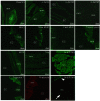Mechanisms of muscle gene regulation in the electric organ of Sternopygus macrurus
- PMID: 23761472
- PMCID: PMC3680507
- DOI: 10.1242/jeb.082404
Mechanisms of muscle gene regulation in the electric organ of Sternopygus macrurus
Abstract
Animals perform a remarkable diversity of movements through the coordinated mechanical contraction of skeletal muscle. This capacity for a wide range of movements is due to the presence of muscle cells with a very plastic phenotype that display many different biochemical, physiological and morphological properties. What factors influence the maintenance and plasticity of differentiated muscle fibers is a fundamental question in muscle biology. We have exploited the remarkable potential of skeletal muscle cells of the gymnotiform electric fish Sternopygus macrurus to trans-differentiate into electrocytes, the non-contractile electrogenic cells of the electric organ (EO), to investigate the mechanisms that regulate the skeletal muscle phenotype. In S. macrurus, mature electrocytes possess a phenotype that is intermediate between muscle and non-muscle cells. How some genes coding for muscle-specific proteins are downregulated while others are maintained, and novel genes are upregulated, is an intriguing problem in the control of skeletal muscle and EO phenotype. To date, the intracellular and extracellular factors that generate and maintain distinct patterns of gene expression in muscle and EO have not been defined. Expression studies in S. macrurus have started to shed light on the role that transcriptional and post-transcriptional events play in regulating specific muscle protein systems and the muscle phenotype of the EO. In addition, these findings also represent an important step toward identifying mechanisms that affect the maintenance and plasticity of the muscle cell phenotype for the evolution of highly specialized non-contractile tissues.
Keywords: electrocyte; muscle regulatory factors; muscle-derived cells; post-transcriptional regulation.
Figures





Similar articles
-
Evidence of post-transcriptional regulation in the maintenance of a partial muscle phenotype by electrogenic cells of S. macrurus.FASEB J. 2006 Dec;20(14):2540. doi: 10.1096/fj.06-6474fje. Epub 2006 Oct 31. FASEB J. 2006. PMID: 17077280
-
Expression of myogenic regulatory factors in the muscle-derived electric organ of Sternopygus macrurus.J Exp Biol. 2008 Jul;211(Pt 13):2172-84. doi: 10.1242/jeb.016592. J Exp Biol. 2008. PMID: 18552307 Free PMC article.
-
Transcription of MyoD and myogenin in the non-contractile electrogenic cells of the weakly electric fish, Sternopygus macrurus.Dev Genes Evol. 2004 Aug;214(8):380-92. doi: 10.1007/s00427-004-0421-5. Epub 2004 Jul 28. Dev Genes Evol. 2004. PMID: 15309633
-
Electrocyte physiology: 50 years later.J Exp Biol. 2013 Jul 1;216(Pt 13):2451-8. doi: 10.1242/jeb.082628. J Exp Biol. 2013. PMID: 23761470 Review.
-
Development and regeneration of the electric organ.J Exp Biol. 1999 May;202(Pt 10):1427-34. doi: 10.1242/jeb.202.10.1427. J Exp Biol. 1999. PMID: 10210683 Review.
Cited by
-
Studying convergent evolution to relate genotype to behavioral phenotype.J Exp Biol. 2020 Feb 7;223(Pt Suppl 1):jeb213447. doi: 10.1242/jeb.213447. J Exp Biol. 2020. PMID: 32034050 Free PMC article. Review.
-
Unique patterns of transcript and miRNA expression in the South American strong voltage electric eel (Electrophorus electricus).BMC Genomics. 2015 Mar 26;16(1):243. doi: 10.1186/s12864-015-1288-8. BMC Genomics. 2015. PMID: 25887781 Free PMC article.
-
A chromosome-level genome assembly of Electrophorus voltai, a species of electric eel.Sci Data. 2025 Aug 6;12(1):1367. doi: 10.1038/s41597-025-05720-3. Sci Data. 2025. PMID: 40769985 Free PMC article.
-
The myogenic electric organ of Sternopygus macrurus: a non-contractile tissue with a skeletal muscle transcriptome.PeerJ. 2016 Apr 14;4:e1828. doi: 10.7717/peerj.1828. eCollection 2016. PeerJ. 2016. PMID: 27114860 Free PMC article.
References
-
- Ai J., Zhang R., Gao X., Niu H.-F., Wang N., Xu Y., Li Y., Ma N., Sun L.-H., Pan Z.-W., et al. (2012). Overexpression of microRNA-1 impairs cardiac contractile function by damaging sarcomere assembly. Cardiovasc. Res. 95, 385-393 - PubMed
-
- Allen D. L., Sartorius C. A., Sycuro L. K., Leinwand L. A. (2001). Different pathways regulate expression of the skeletal myosin heavy chain genes. J. Biol. Chem. 276, 43524-43533 - PubMed
-
- Ambros V. (2004). The functions of animal microRNAs. Nature 431, 350-355 - PubMed
-
- Arnold H. H., Braun T. (1996). Targeted inactivation of myogenic factor genes reveals their role during mouse myogenesis: a review. Int. J. Dev. Biol. 40, 345-353 - PubMed
Publication types
MeSH terms
Substances
Grants and funding
LinkOut - more resources
Full Text Sources
Other Literature Sources
Molecular Biology Databases

